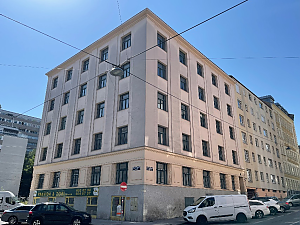fERNkornSAN – decarbonization and renovation with renewable materials of the "Gründerzeit"-building Fernkorngasse 41
Short Description
Starting point/ motivation
In order to achieve the set climate targets and climate neutrality, it is necessary to replace fossil fuels in the housing stock with renewable alternatives in the near future. This also requires improving the thermal quality of existing buildings by using resource-saving and ecological materials. Climate change is already presenting us with major challenges today, and these will only increase in the future.
It is therefore essential to ensure that large-scale thermal refurbishment measures and the conversion of heating systems are implemented in a holistic manner that is adapted to climate change. In addition to the use of ecological materials, this also includes the use of efficient technologies and recyclable systems as well as increased comfort and economic benefits for all those involved in order to make buildings future-proof.
The aim is therefore to find simple, affordable, ecological and practicable solutions for thermal refurbishment, changing energy sources and adapting to climate change for the various types of existing buildings.

Contents and goals
The project aims to investigate technical challenges and issues related to phasing out gas and oil, as well as adapting to climate change, using the example of the "Gründerzeit"-building at Fernkorngasse 41, 1100 Vienna. Through the use of ecological materials and highly efficient technologies, demonstrative solutions for feasibility in existing buildings are to be developed.
A particular focus is placed on the use of resource-efficient and ecological building materials such as glass bead plaster, sheep wool insulation and straw as well as highly efficient technologies (wastewater heat recovery, heat pumps with geothermal probes on public ground). Decentralized home stations are used for hot water supply, an energy-efficient and low-maintenance solution for the building in question. These measures are complemented by climate-adapted construction, including sun protection and facade greening.
The goal is to develop exemplary, future-proof renovation measures with the smallest possible ecological footprint. The use of materials and technological combinations that are not yet widely applied is being researched and made accessible.
Methods
The first step is to develop the basic principles (preliminary investigations of the building and clarification of the necessary preparations for the use of materials.). This is followed by the planning and implementation of the measures to be carried out. After implementation, close monitoring is carried out for evaluation purposes. The results are disseminated by summarizing the findings, presenting them in a workshop and disseminating them through publications and lectures.
Expected results
Through the application and investigation of new materials, technologies and their combinations, scaling possibilities and application potentials for different building types and specific problems are analysed. These findings are used to develop recommendations and practical instructions in the form of a package of measures. The results promote awareness, availability and further development of the products and can be used in future projects and refurbishment plans.
The comprehensive monitoring provides - in addition to the analysis of energy consumption, comfort values and resident satisfaction - in particular findings on the use of ecological building materials, the efficiency of decentralized wastewater heat recovery and the cost-effectiveness of the demonstrative implementations.
Project Partners
Project management
Schöberl & Pöll GmbH
Project or cooperation partners
- Trimmel Wall Architekten ZTGmbH
- Passivhaus Institut GmbH
- Kuhn Friederike
- hacon GmbH
- GrünStattGrau Forschungs- und Innovations GmbH
- Dr. Alexander Keul
- BauXund Forschung und Beratung GmbH
Contact Address
Schöberl & Pöll GmbH
Lassallestraße 2/6-8
A-1020 Wien
Tel: +43 (1) 726 45 66
E-mail: office@schoeberlpoell.at
Web: www.schoeberlpoell.at
